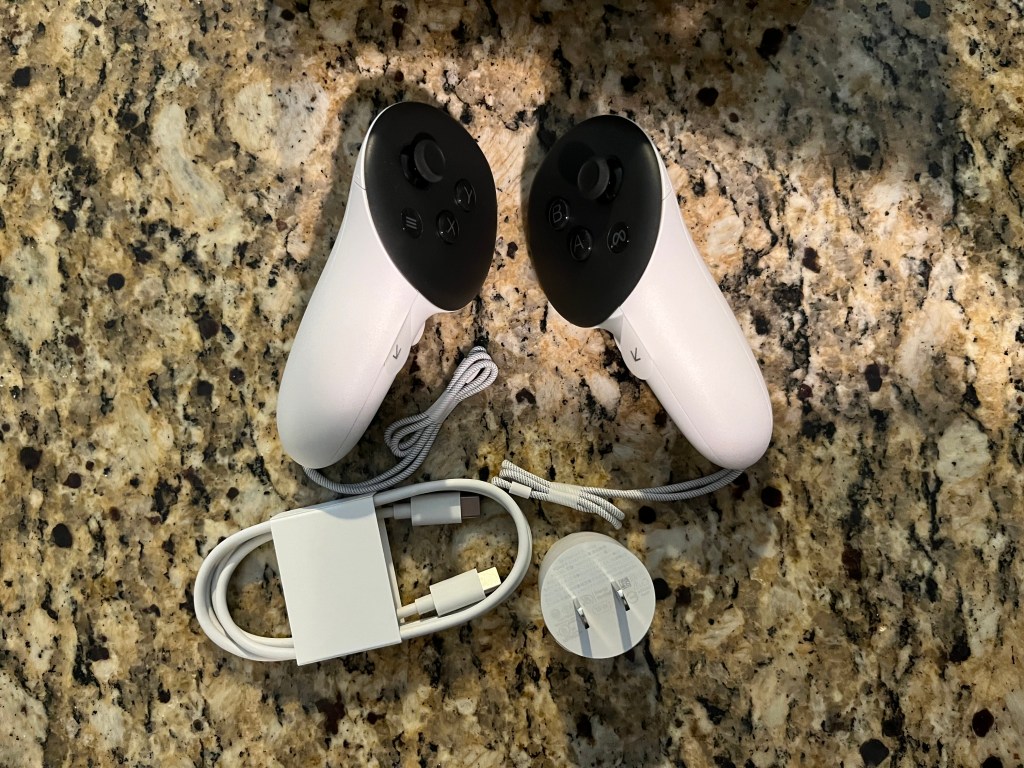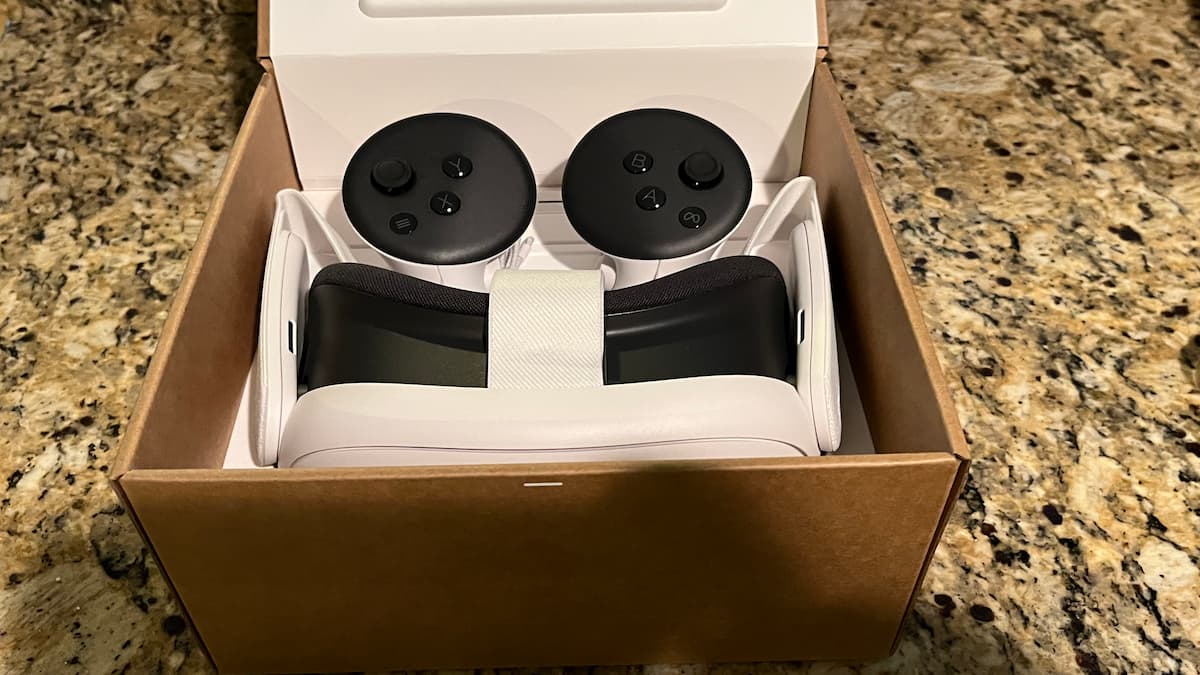The last time we checked in with Facebook’s ongoing quest to dominate the VR market, their leading headset was called the “Oculus Quest 2.” Now, we’re in a post-Oculus world with the Meta Quest 3. Time to check in and see how much consumer-grade VR has progressed in the past three years. Spoiler: it’s come quite far!

Product: Meta Quest 3
Manufacturer: Meta
Input: One USB-C charger
MSRP: $499 (128GB), $649 (512GB)
The first thing you’ll notice about the Meta Quest 3 is the price tag. Previously, the Oculus Quest 2 was sold at $299 for 64GB and $399 for 256GB. Now we’re up to $499 as a base price for 128GB, and $649 for a whopping 512GB. The doubling of storage space for the regular and premium models makes sense, as the ever-encroaching file sizes of VR games have expanded monumentally.
I’ve gone through the motions of setting up every consumer-grade Oculus to date since the first Rift debuted in 2016, and the Meta Quest 3’s process is by far the easiest. All it takes is turning it on, scanning a QR code, and logging in. From there I was into my account in minutes, downloading everything that had been associated with my account thus far.
Immediately, I saw a stark difference between how the Meta Quest 3 handles passthrough (read: the ability to see the real world around you while the VR headset is on your head). It’s a marked increase from the headsets prior to it, to the point where I could read (albeit with some squinting) text on various screens. It was extremely helpful for setup (like glancing at the app during passthrough), and two taps to the side of the Meta Quest 3 can enable/disable passthrough at any time. From a hardware and software perspective, the Meta Quest 3 is more responsive than its predecessors. The onboard Qualcomm Snapdragon XR2 [Gen 2] helps.
There’s also a cool cartoony effect on the Touch Plus controllers in VR space (whether they’re in your hands or across the room on the floor) that helps them stand out more. It’s all a lot clearer than it was in the past, and helps showcase why passthrough matters; especially for folks with smaller spaces. It’s something you don’t think about often, but it can deter people from getting into a VR session if there’s any clunk in the way. It’s an unfortunate reality of the medium, but again, the Quest 3 has eliminated a lot of that guesswork and annoyance.
Another bit of setup wizardry involves automatic room scale detection. Although you can manually “spray paint” your room to devise your own boundaries (so you don’t bump into stuff), the automatic scan option is a Godsend. I can’t tell you how many times I annoyingly had to make and remake boundaries on the Oculus Quest 2, to the point where it occasionally deterred me from even using it. Sometimes you only have a few spare moments to jack into VR (I still love saying that, no matter how cheesy it is), so the quicker I can get in, the better.
Even with just the pageantry of the setup under my belt, I was taken aback at how far of a leap the Meta Quest 3 was from the prior generation of tech. Although it does feature a leap in price as well, VR enthusiasts will likely notice the stark difference straight away, and newcomers will be more wowed by the Quest 3 than any other model before it.


I try to refrain from using the word “immersive” when it’s meaningless, but the lighter feel of both the headset and the dual Touch Plus controllers feel like a big upgrade when you’re actually using it. The Touch Plus controllers didn’t take much getting used to, and work almost 1:1 like the prior Oculus Touch remotes: just without that futuristic band around your hand.
I’ve talked at length about the quality of the Touch controller family in the past, but it’s worth singing its praises again. They’re intuitive and easy to use, involve tactile buttons for precision, and are used ingenuously by the vast majority of developers out there at this point.
As for the games, the Quest storefront is a powerhouse of VR classics in 2023. I mean, they took their sweet time getting there after nearly a decade, but there are a ton of mainstream and niche VR games on the marketplace to peruse through, spanning tons of different genres. We contacted Meta to get an idea of what games we should really take for a test drive with the Quest 3 to see the difference, and a rep gave us the following list:
- Red Matter 2
- The Cabin
- Demeo Battles
- Dungeons of Eternity
- Islanders
- Kurzgesagt
- Les Mills Bodycombat
- SEGA’s Samba de Amigo
- Xponential+
- Xtadium

That same rep also clarified that every prior Quest game was backward compatible with the Quest 3, which is always great to hear. Titles like Pistol Whip are already markedly improved through Quest 3-enhanced builds, and the new controllers/headset make every game inherently smoother to play. The Quest 3 doesn’t necessarily have a killer “launch lineup,” so Quest 2 users might need a bigger push (like a lower price) to upgrade, but the above titles are stacked on top of a massive library of Alexandrian proportions.
I found myself going back to old favorites like Robo Recall and Resident Evil 4 VR, and had a blast. Resident Evil 4 VR in particular (the OG one, not the one for the PSVR 2) is still incredibly impressive, especially with the new VR-specific mechanic of dual/independent hand manipulation. Every time I play the remake, I find myself pining for the VR-centric experience of tossing an egg directly at a Ganado’s face with my real arms.
If you haven’t jumped into the Oculus/Quest suite of devices yet, now is a pretty good time, even if you manage to snag a Quest 2 on the cheap. The Quest 3 is more than an incremental change, but the general vibe of cordless VR is still at the forefront.
[A full retail 512GB Meta Quest 3 headset was provided by Meta for testing.]








